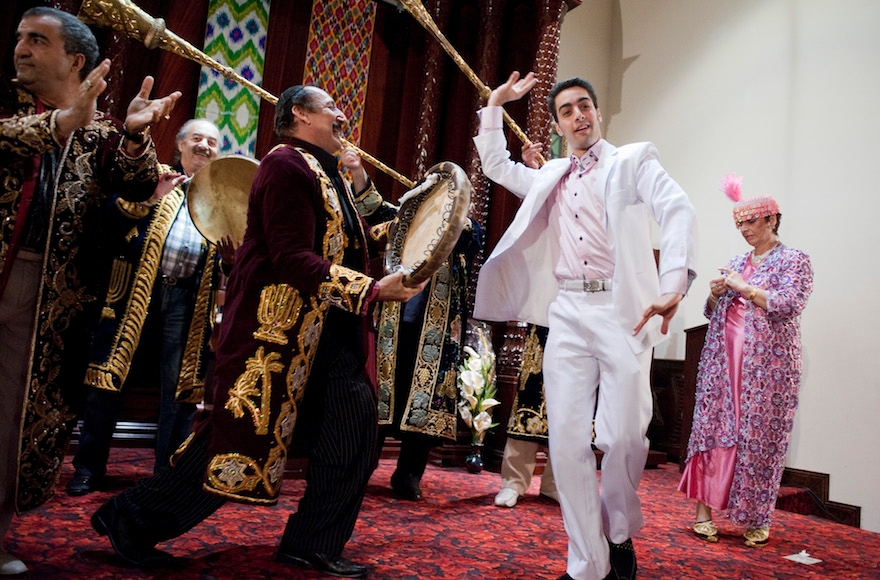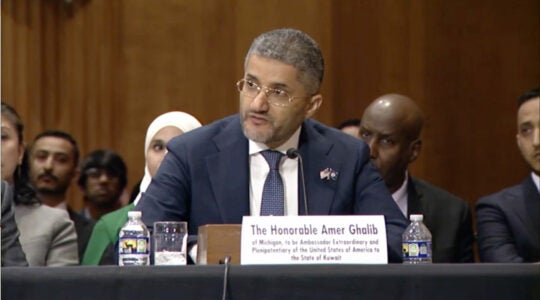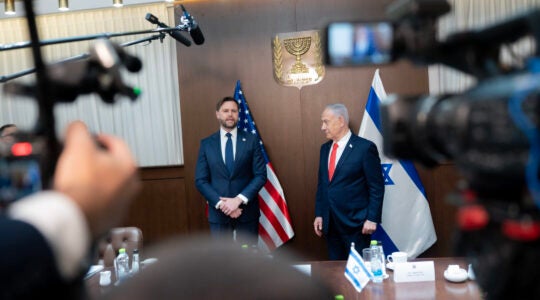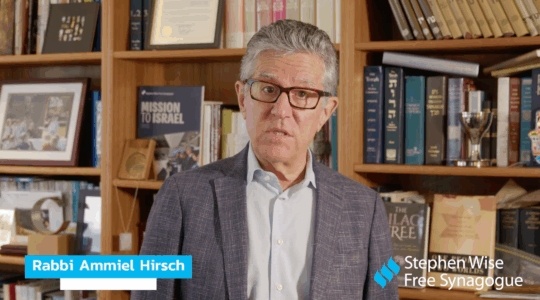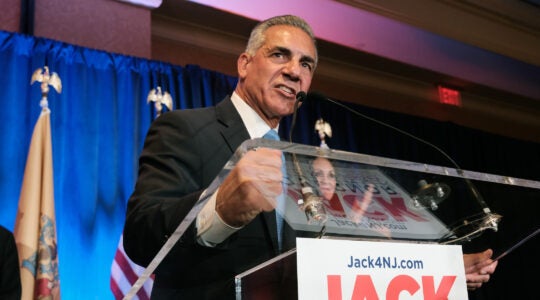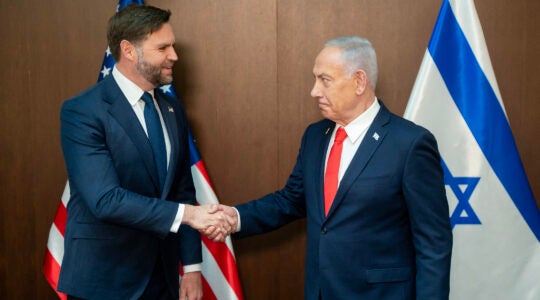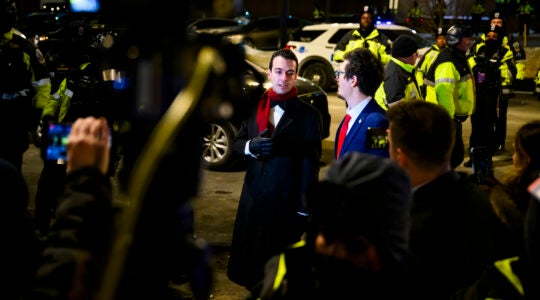This story is sponsored by the Orthodox Union.
NEW YORK — The restaurants are packed on the wide boulevard in the Queens borough of this city known as the Bukharian Broadway.
At Da Mikelle, one of many kosher eateries featuring Bukharian cuisine, families crowd the dining rooms to mark the occasion of a yushvo, the anniversary of a loved one’s death.
Down the road, the Beth Gavriel synagogue and community center is obscured by scaffolding and construction cones. Inside, dozens of men sit late on a Monday night hunched over volumes of Talmud and Torah, their animated discourse filling the study hall. In the main sanctuary, prayer books and Bibles in Hebrew and Russian translation line the shelves. Once the construction is complete, the community will have a new multipurpose center that will include mikvah ritual baths, expanded prayer rooms and events space.
“We have four minyanim on Shabbat — three of them youth services,” boasted Yaniv Meirov, the executive director of a community organization Chazaq, which runs some programming for young adults at Beth Gavriel.
The construction, bustling restaurants and lively study sessions are all signs of the growing size and significance of New York’s Bukharian Jewish community.
“We had only one synagogue 30 years ago. Now we have 40,” said Rafael Nektalov, editor in chief of the community weekly, Bukharian Times. “While other Jews who lived here moved away to Long Island or Miami, Bukharian Jewish people saved the face of Orthodox Jewry in Queens.”
Once fledgling, the Bukharian community in New York now makes up the largest concentration of Bukharian Jews outside of Israel with an estimated 50,000 members in Queens, according to communal leaders. They have their own schools, restaurants, a museum, a newspaper and a cemetery. A community radio station is scheduled to launch in April.
Queens alone has some half-dozen Bukharian schools, not counting regular Jewish day schools with large Bukharian student populations. Beth Gavriel’s school, Sha’arei Zion, has more than 600 students. The boys high school is bursting at the seams, and a high school for girls is slated to open next year.
All the growth is bringing about another major change for the community. Long marked by insularity, the Bukharian Jewish community is building new bridges with the broader American Jewish community in an effort to confront a new set of challenges. Whereas a generation ago the newly immigrant community’s main struggle was adapting to life in America, today the community is facing the challenges of how to maintain its distinct Jewish identity, pay for Jewish day school and keep kids engaged while their parents are at work.
“Here in the United States we have freedom of speech, freedom of religion – everything is freedom everywhere,” said Imanuel Rybakov, 34, a young community leader who teaches a Jewish studies course at Queens College titled “History and Culture of the Bukharian Jews.”
“We’re successfully integrating into American Jewish society,” Rybakov said. “But at the same time we’re losing a lot of our ethnic culture based on Central Asian customs and culture.”
Bukharian Jews got their name and distinct cultural identity from the Emirate of Bukhara that once stretched over swaths of modern-day Uzbekistan, Tajikistan and Turkmenistan. Most of the Bukharians who immigrated to the United States came from Uzbekistan, and many originally were from the city of Bukhara, which was formerly part of the Persian Empire.
A trickle of Bukharian immigration to New York began in the early 1970s, but it turned into a wave after the fall of the Soviet Union, transforming parts of Queens into a distinct ethnic enclave now known more broadly as Queensistan. Many shop signs throughout Forest Hills and the adjacent Rego Park neighborhood are in English and Russian. Many community members speak Bukharian, a Persian dialect, in addition to Russian.
The synagogue is the locus of communal life for many of these Sephardic Jews. Among the numerous Bukharian shuls in Queens are homes that have been repurposed into synagogues and minyans that meet in private homes. Although many Bukharian Jews in the United States are not strictly Orthodox, they are overwhelmingly traditional and favor Orthodox synagogues over non-Orthodox ones.

From left to right: Synagogue teen programming director Yaniv Meirov, lay leader Simcha Mushayev and Rabbi Ilan Meirov are excited about the expansion of their synagogue, the Beth Gavriel Center of Bukharian Jews, in Queens, N.Y. (Rachel Delia Benaim)
“Bukharian Jews were stripped of their religiosity in the former Soviet Union,” Meirov said. “But when they came to America they clutched to the traditions.”
Perhaps more than anything else, the tight-knit community has been held together through the bonds of marriage. Few wed outside the Bukharian community, and marrying out of the faith is exceedingly rare.
“We’re all friends, we’re all family,” said Rabbi Ilan Meirov, Yaniv’s older brother and one of the rabbis at Beth Gavriel.
In recent years, stresses on the community have increased. With their growing Jewish student population, the community is straining under the weight of parochial school tuition fees and concerns about youth engagement. There is mounting concern about the threat of drug and alcohol abuse – problems that did not exist back in Bukhara, community members say. Several weeks ago, four young people from the community died of drug overdoses, according to Nektalov, the newspaper editor.
These challenges have prompted the Bukharian community to look outward as never before. In 2013, the Jewish Child Care Association helped launch a program called the Young Bukharian Leadership Institute to aid Bukharian Jewish college students and young professionals develop leadership skills and build bridges to the larger Jewish community.
Last year, Beth Gavriel became the second Bukharian shul to join the Orthodox Union’s network of Orthodox congregations; Kehilat Sephardim of Ahavat Achim joined in 2014. The O.U. is also looking to expand the relationship between the Bukharian community and the National Council of Synagogue Youth, the O.U.’s teen programming division known by the acronym NCSY. In March, Bukharian Jews for the first time joined the O.U.’s annual lobbying trip to Albany, the New York state capital, to advocate for issues of importance to their community.
“Synagogue servicing is just a gateway to accessing the variety of programming which the O.U. offers,” said Yehuda Friedman, the O.U. Queens regional director.
On the political front, Bukharian Jewish leaders have formed their own lobbying group, the Alliance for Bukharian Americans, to represent the community’s interests to local and state government. The goal is to have the group be the voice for all Bukharian Americans – not just in New York, but also for the growing Bukharian communities in Arizona, Colorado and Florida.
The alliance’s goals are to obtain government funding for Jewish schools, secure grant funding for afterschool programs, get funding for Bukharian Jewish community centers and educational institutions, and “defend the security and welfare of the State of Israel,” according to the official mission statement.
“We need to make our voices heard in the political world,” said Simcha Mushayev, a community leader who is involved in the political action committee.
The community’s main umbrella organization is the Bukharian Jewish Congress of the United States and Canada.
Maury Litwack, director of the O.U.’s Teach-NYS advocacy effort, has worked closely with the Alliance for Bukharian Americans on day school advocacy efforts. He noted that the community is quick to mobilize and get elected officials involved.
“We are excited to be building this partnership with a community that is at once rooted in tradition as well as forward-looking and invested in its future,” Litwack said.
(This article was sponsored by and produced in partnership with the Orthodox Union, the nation’s largest Orthodox Jewish umbrella organization, dedicated to engaging and strengthening the Jewish community, and to serving as the voice of Orthodox Judaism in North America. The article was not produced by JTA’s staff reporters or editors.)
JTA has documented Jewish history in real-time for over a century. Keep our journalism strong by joining us in supporting independent, award-winning reporting.
